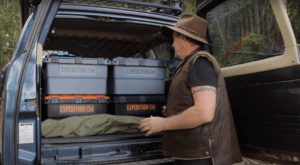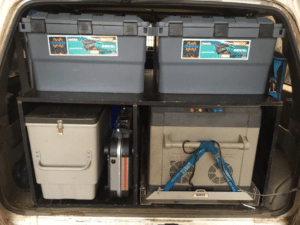 How using 4wd Storage Boxes by Expedition 134 can Reduce 4WD Storage Weight:
How using 4wd Storage Boxes by Expedition 134 can Reduce 4WD Storage Weight:
When people start organising their 4×4 touring setup, there’s a general trend towards packing in too much gear. Unfortunately, the whole “just in case” mentality doesn’t exactly work for 4WDing. Overpacking is a quick way to weigh down your 4WD unnecessarily.
Reducing 4WD weight not only improves your vehicle’s performance, but also pushes you to create a more organised 4×4 touring setup. Some of Australia’s biggest 4WDing personalities are now opting for a minimalist approach. But before we check out their weight-loss strategies, let’s look closer at why reducing 4WD weight is important.
Why is Reducing 4WD Weight Important?
Funnily enough, many 4WDers don’t actually know what their 4WD weighs when it’s fully packed with gear and people. Fortunately, there are some weighbridges around Australia in certain areas where you can check if your 4WD needs a diet. Don’t have a weigh bridge near you? Visit your local dump or recycling centre. They’ll often let you use their weighbridge free of charge or for a small fee.
There are also some specialists that can assist specifically with vehicle weight set ups to ensure you are correctly weighted and therefore legal on the road. This also means if you do have an accident you know your insurance won’t be an issue. There is a good article with Club 4×4 going through the process of weighing their 4wd and Tvan.
Lightening your 4WD can provide a number of positive benefits, particularly when it comes to wear and tear, vehicle handling and insurance liability.
Firstly, lowering your 4WD’s weight means you’re putting less stress and strain on various other parts of your vehicle. Wheel bearings, suspension, the chassis and even engines are all affected by your vehicle’s weight. Driveline components, such as universal joints on the drive shaft and the CV joints on the front hubs, are weak points when under too much load. Axles in particular also have a load rating that many drivers don’t know about. If you want your 4WD running reliably and performing better both on and off road, ditch the excess weight.
The next point of concern is insurance and warranty. If you exceed the manufacturer’s weight allowances, you may actually void your vehicle’s warranty. In the same vein, an overweight 4WD may not be considered roadworthy. So if you have an accident, your insurance policy could well be declined.
Having a lighter 4WD also really improves your vehicle’s performance. A lot of drivers notice better handling, acceleration and power from their 4WDs when they’re not weighed down. You’ll certainly find it easier to scale that big sand dune or steep track. Last but not least, fuel economy drastically improves with less weight. It’ll also be much easier to recover your vehicle out of a bog.
Ultimately, you need to address your vehicle’s Gross Vehicle Mass (GVM). The GVM is the maximum weight your vehicle can be at any time. Work out the difference between your vehicle’s GVM and tare mass to determine the amount of weight you can add to your 4WD. Commonly called the “payload”, this is any weight sitting in or on your vehicle. It covers passengers, fuel, water, accessories, equipment, emergency gear, food and clothes. It also includes the weight a trailer applies to your tow ball.
Consider the weight difference of larger tyres and rims as well. For instance, the difference between 5×35” mud tyres on steel rims, and standard size AT tyres on alloy rims, could be as high as 100 kilograms or more.
4WDs typically come with a payload of between 600 kilograms and 1,100 kilograms. Believe us when we say it’s surprisingly easy to max out this weight very quickly, especially for families or anyone carrying extra fuel and water. That’s why it’s so important to shed weight wherever possible.
But how exactly do you reduce your 4WD’s weight?
Easy Ways to Reduce 4WD Weight
Automotive manufacturers have started producing more types of 4WDs with bigger payloads. However, you don’t need to spend the extra money if you focus a little on reducing weight in your vehicle. Here are some easy ways to reduce 4WD weight.
- Ditch the 4wd steel drawers for 4WD storage boxes.4×4 storage boxes like the Expedition 134 boxes offer safe and reliable storage without the extra weight or inflexibility of steel drawers. At 3.95kg they are up to 50% lighter than comparable sized storage boxes.
- Remove any unnecessary seating.If you’re not touring with a family, you can save weight by removing the backseats. However, don’t do so before knowing your state’s rules and regulations surrounding this. You can find more information on 4wd vehicle modifications to ensure your vehicle remains compliant in Queensland here. Other States and Territories would have similar information.
- Opt for lightweight accessories or cut out the unnecessary ones.Take a long hard look at your 4WD and decide which accessories are really needed for your trip. Review what gear you have actually used on your last trips and what might not be essential. For example, choose the right size bullbar for your needs and invest in accessories that can be easily removed when you’re not using them.
- Opt for lightweight tools and supplies.You can save a lot of weight by keeping your camp kitchen minimalistic with just enough dishes for every meal. You can also buy light plastic dishes and cups that won’t weigh you down as much. The guys at WandsPro have a great range of lightweight crockery that clips together and doesn’t rattle or spill in your storage box.
- Consider ditching the cast iron cooking tools.The traditional cast iron camp oven and steel barbecue plates have long been favoured by campers and 4WDers. However, they’re heavy beasts. Think about how often you actually use them. They could be substituted for something lighter, such as the spun steel Bedourie Camp Oven. Southern Metal Spinners have a great range of spun steel cookware to consider.
How the Pros are Reducing Their 4WD Weight
- Tim Bates

Aussie 4WDing legend, Tim Bates, overhauled the interior of his GU Patrol a couple of years ago with an emphasis on reducing overall weight. Tim was pretty darn resourceful with his modifications, sourcing a lot of materials from his local hardware store. He also removed the back seats to create extra storage space.
Tim also took weight balance into consideration. His new 4×4 touring setup enables him to store heavier items, such as water tanks and his fridge, closer to the 4WD’s centre of gravity. This creates better weight balance within the vehicle. One of Tim’s biggest weight-shedding solutions was also swapping his heavy timber storage drawers for some Expedition 134 4×4 storage boxes. In the end he removed around 300 kilograms in weight.
So what were the benefits from Tim’s weight shedding? He actually reported a number of noticeable changes to his 4WD’s performance. This included a better stopping distance, lower Exhaust Gas Temperatures and better handling on and off the road.
2. Mark Batty

Removing excess weight was a bit tougher for Victorian 4WDer, Mark Batty. He wanted to reduce weight for 4wd touring a few years ago but still have room for the family. Already Mark was dealing with a lot of weight from passengers and supplies.
Despite this, Mark was still able to remove around 50 kilograms of excess weight from his GU Patrol. How exactly did he do this?
Mark’s GU Patrol was originally fitted out with a set of steel Titan drawers that weighed around 80 kilograms when empty. Mark removed the steel 4WD drawers then custom-built shelving from scrap plywood. For storage, he went with a couple of our Expedition 134 4WD storage boxes shortly after they were release (still got the original branding stickers).
Mark’s biggest pros from his new 4×4 touring setup were more storage space and weight for supplies and greater flexibility. He’s managed to even add a freezer to his setup thanks to the extra weight allowance. All in all, the job took him five or so hours to complete and cost about $100.
Read more about Mark Batty’s weight saving 4WD setup.
3. What did I do?
I recently added some more weight allowance to my 4WD. Unlike Tim and Mark, Nic didn’t remove anything from his 4×4 touring setup. Instead, he had previously upgraded suspension inspected and approved for a 10-percent GVM upgrade in Queensland. This upgrade took his 2011 Landrover Defender’s GVM from 3,050 kilograms to 3,400 kilograms. A blue compliance plate was fitted to the vehicle and the upgrade was registered with the Queensland Department of Transport.
The most important thing to consider when upgrading your GVM is ensuring your upgrade is approved and complies with legislation and insurance. If you’re looking for a GVM upgrade, remember that there are variations in legislation between states, along with federal regulations to consider.
We suggest that you seek guidance from a registered aftermarket provider, or better yet, an engineer who approves such changes. You don’t want to be one of those who starts changing their vehicle setup before finding out it won’t be approved. The benefit of a GVM upgrade can be substantial though. Usually between 200 and 500 kilograms in payload.
Reduce 4WD Weight for Your 4WD’s Sake
There’s no denying it, excess weight wears down your 4WD. All the bumps, humps and holes in the outback are that much more damaging with another 200 or so kilograms behind them. You’ll also notice a significant decrease in fuel efficiency and overall vehicle performance. If you want your 4WD to help you explore with confidence, make sure it’s not overweight.
Sometimes keeping it simple is the best weight-loss method. Your gas barbecue, coffee machine and hair dryer might be nice luxuries, but are they worth the extra weight, effort and risk? Ask yourself if you really need the extra gear. Because it not only places extra strain on your 4WD, but can also be a real pain when setting up and packing up camp.
